What is Ocean Acidification?
The ocean absorbs about 30% of the carbon dioxide (CO2) released to the atmosphere each year due to human activities. The CO2 absorbed by the ocean reacts with seawater, causing changes in the carbonate chemistry, a process referred to as ocean acidification. This dissolved CO2 reacts with seawater to form carbonic acid (H2CO3), which dissociates to form bicarbonate ions (HCO3-) and hydrogen ions (H+), while increasing the partial pressure of CO2 (pCO2). This reaction increases the concentration of hydrogen ions (H+) and lowers the pH of the seawater. The increased hydrogen ion concentration further decreases the amount of carbonate ions (CO32-) by forming bicarbonate (HCO3-), making carbonate ions relatively less abundant. The decrease in carbonate ion concentrations lowers the saturation state of biogenic calcium carbonate minerals, including calcite and aragonite, and can reduce the ability of organisms to calcify (e.g. reef building corals and shelled molluscs).
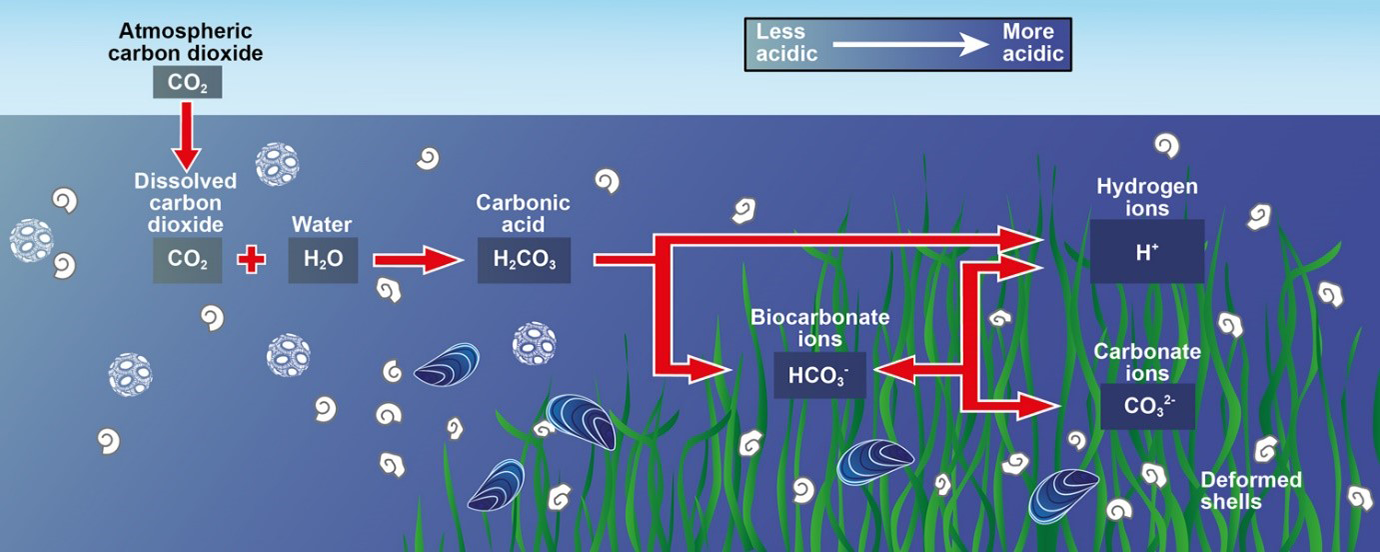
Source: Plymouth Marine Laboratory
Coastal acidification can occur as a result of local processes altering local water chemistry. Such changes can be attributed to eutrophication resulting in algal blooms and ultimately releasing CO2 when algae decompose. Coastal acidification can also occur when changes in water column circulation occur, for example as a result in wind, temperature, or salinity changes. Coastal acidification can also naturally; coastal upwelling is a process by which deeper, more acidic waters are transported to the surface ocean in the coastal zone. Coastal regions are expected to be strongly affected by ocean acidification, but their highly dynamic environment and the great many influences such as temperature changes, freshwater run-off, nutrient influx and biological activity, make it difficult to uncover the specific reasons/drivers for and impacts of ocean acidification on coastal environments. In order to characterize the variability of coastal acidification, and to identify the drivers and impacts, a high temporal and spatial resolution of observations is crucial.
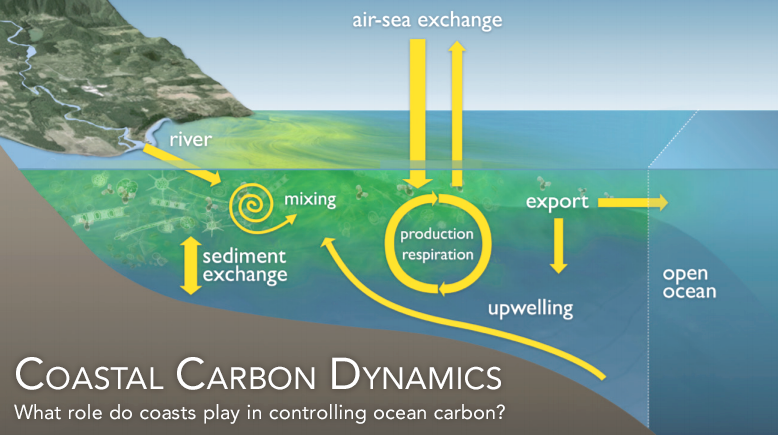
Coastal regions experience complex biogeochemical processes which influence carbon dynamics and can contribute to coastal acidification. Source: NOAA/PMEL.
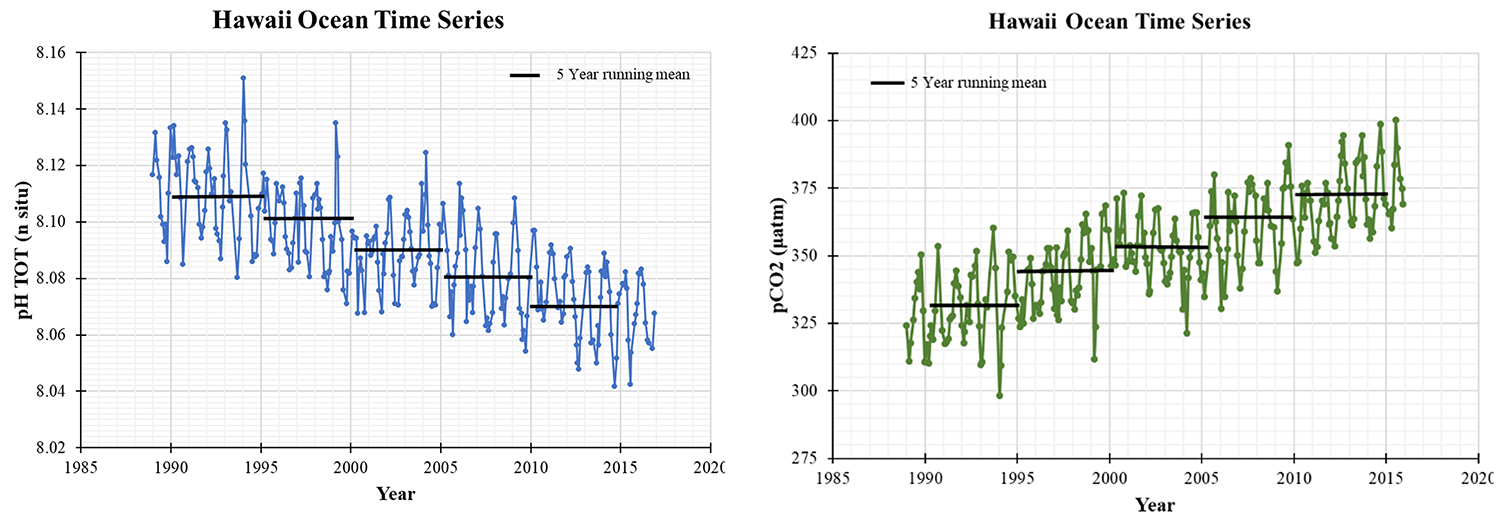
Sustained ocean time-series are critical for capturing trends in ocean acidification. Source: The Global Climate in 2015–2019, WMO 2019
Biological Impacts of Ocean Acidification
Ocean acidification has been shown to cause a range of responses at the organism level that can affect biodiversity and ecosystem structure. Direct consequences for marine life can propagate through the food web and affect ocean-related services and uses, including food security from fisheries and aquaculture, livelihoods, transportation, coastal protection, tourism, and cultural heritage. Decreases in dissolved carbonate ion concentrations have been shown to impact the growth and larval survival of key marine calcifying organisms, including oysters, crabs, mussels and corals. The production and harvest of seafood from marine calcifiers in both wild and aquaculture-based fisheries is expected to decline, with some aquaculture facilities already implementing monitoring and adaptation strategies for ocean acidification. The impacts on coral reefs are numerous, and the changes in seawater chemistry are expected to shift reefs to a condition of net dissolution and toward more algal dominated ecosystems. Weaker reef structures are more prone to storm damage and offer less protection. Together, this leads to a decrease in the structural complexity and biodiversity of the reefs. Effects on growth, reproduction, and predatory avoidance have also been observed for many other marine organisms including non-calcifying species, such as fish larvae, due to changes in pH and/or pCO2 and dissolved bicarbonate.
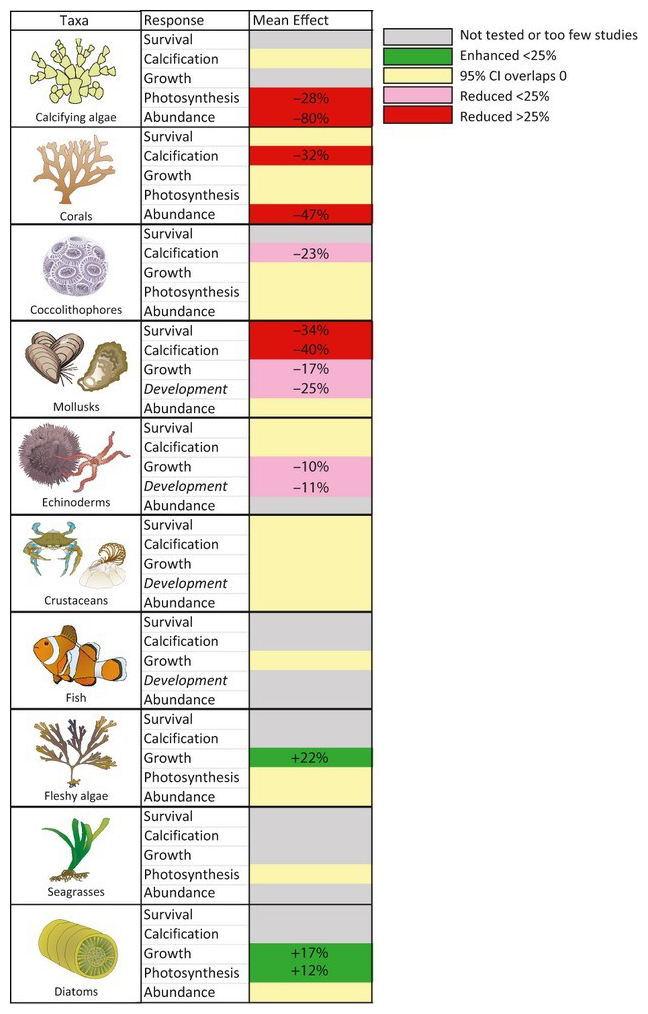
Summary of effects of acidification among key taxonomic groups. Effects are represented as either mean percent increase (+) or percent decrease (-) in a given response. Source: Kroeker et al 2013, Global Change Biology.
What is Being Done?
Monitoring to improve the understanding of variability and rates of change in ocean acidification at local to global scales, combined with studies of biological impacts are central aims of the Global Ocean Acidification Observing Network (GOA-ON). The network is working with partners to build capacity and awareness of ocean acidification around the world. An integrated network of observations is helping to understand biological impacts of ocean acidification in the context of multiple stressors, including increased temperature, changes in nutrient concentrations and lower dissolved oxygen concentrations. Modellers involved in GOA-ON are using the observations to ground truth forecasts and to optimize biogeochemical models related to ocean acidification.
Translating the Science into Action
The need for monitoring of ocean acidification and its impacts on marine ecosystems has been recognized at intergovernmental levels including by the UN General Assembly, the UN Convention on the Law of the Sea, the Convention on Biological Diversity, and the Intergovernmental Panel on Climate Change (IPCC). The UN General Assembly in 2015 established ocean acidity as one of 10 targets for the Sustainable Development Goal 14 for the Ocean. The Intergovernmental Oceanographic Commission (IOC) of UNESCO is the custodian agency for the Indicator under Target 14.3, which calls to "Minimize and address the impacts of ocean acidification, including through enhanced scientific cooperation at all levels". The Methodology for the Target 14.3.1 Indicator provides mechanisms to facilitate reporting on ocean acidity by Member States. In 2018, the World Meteorological Organization established ocean acidification as a headline climate indicator for reporting to the UN Framework Convention on Climate Change (UNFCCC), and has included ocean acidification in its yearly Statement on the State of the Global Climate. A growing number of governments, working with GOA-ON and partners, have established action plans to address ocean acidification. Additionally, GOA-ON is supporting the formation of regional hubs, which coordinate research and policy responses to ocean acidification at the regional scale.

The Global Ocean Acidification Observing Network is an integrated, international research effort closely linked with other international programs. The diagram below documents the primary international entities responsible for coordination of GOA-ON activities.
